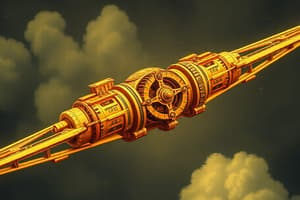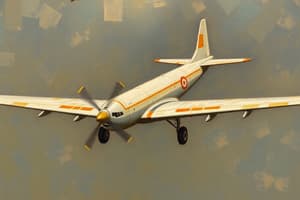Podcast
Questions and Answers
What is the purpose of having two separate circuit breakers for each REU?
What is the purpose of having two separate circuit breakers for each REU?
To provide redundancy for power bus failures.
What is the role of the MCE if both the EBHA REU and EHSA REU are invalid?
What is the role of the MCE if both the EBHA REU and EHSA REU are invalid?
The MCE has a limited capability to control the electrical motor and actuator on its own.
How does the REU receive surface position commands?
How does the REU receive surface position commands?
The REU receives surface position commands from the FCCs on two separate and independent bidirectional ARINC 429 data buses.
What is the role of the hydraulic actuator in the EBHA system?
What is the role of the hydraulic actuator in the EBHA system?
What is the purpose of having two separate FCCs (FCC No. 1 and FCC No. 2) connected to the REU?
What is the purpose of having two separate FCCs (FCC No. 1 and FCC No. 2) connected to the REU?
Flashcards are hidden until you start studying
Study Notes
Aileron Control System
- In normal operation, each aileron surface is controlled by two actuators: one EHSA (Electric Hydraulic Servo Actuator) and one EBHA (Electro-Backup Hydraulic Actuator).
- The two actuators are simultaneously pressurized and active (active/active configuration).
- Left and right inboard actuators are EBHAs, while left and right outboard actuators are EHSAs.
EHSA Operating Modes
- EHSA is controlled electrically by its Remote Electronic Unit (REU).
- EHSA uses hydraulic power to move the control surface.
- EHSA system consists of three separate components: REU, hydraulic manifold, and hydraulic actuator.
REU Functions
- REU electronics box is mounted directly to the hydraulic manifold.
- REU receives electrical power from a single circuit breaker on the essential dc bus (left or right).
- REU receives surface position commands from two separate and independent bidirectional A429 data buses from FCCs (Flight Control Computers) No. 1 and No. 2.
- REU processes FCC signals and initiates electrical commands to the Mode Select Valve (MSV) solenoid and the EHSV (Electro-Hydraulic Servo Valve).
Failure Modes
- If a failure occurs causing either the pilot or copilot roll controls to jam, the person with the operational controls shall be able to provide an input force of large enough magnitude to cause the spring to break out and allow wheel travel.
Aileron Aircraft Control
- Aileron aircraft (roll) control is accomplished by movement of the aileron and spoiler surfaces located on the wing.
- In normal operation, FCCs transmit commanded position on digital data buses to REUs located at each actuator.
- REUs command electrically controlled hydraulic actuators that move the aileron surfaces.
Hydraulic Power
- Hydraulic power to the actuators is separate: left hydraulic system powers left outboard and right inboard EHSA actuators, while right hydraulic system powers right outboard and left inboard EHSA actuators.
- If both left and right hydraulic systems fail, left and right inboard aileron actuators maintain control through the EBHA.
EBHA Functions
- Motor Control Electronic (MCE) in the EBHA activates a hydraulic pump that draws fluid from a self-contained compensator reservoir (manifold).
- Fluid allows the actuator to continue functioning as it did when fluid was provided by the aircraft hydraulic system.
Aileron Deflection
- Aileron deflection is 11° ±1° down and 19° ±1° up.
Studying That Suits You
Use AI to generate personalized quizzes and flashcards to suit your learning preferences.




